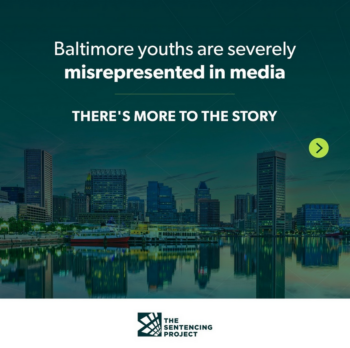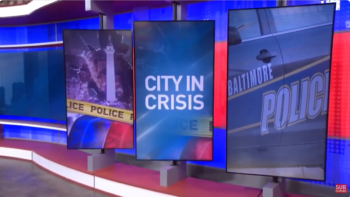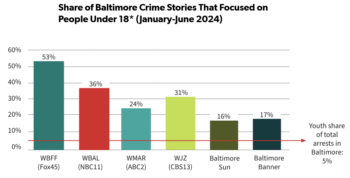Janine Jackson interviewed the Sentencing Project’s Richard Mendel about coverage of youth crime for the December 20, 2024, episode of CounterSpin. This is a lightly edited transcript.

Sentencing Project (12/11/24)
Janine Jackson: Some listeners may know the Sentencing Project for their work calling out racial disparities in sentencing associated with crack versus powder cocaine, and mandatory minimums. A recent project involves looking into another factor shaping public understanding and public policy around criminal justice—the news media. In this case, the focus is young people.
“The Real Cost of ‘Bad News’: How Misinformation Is Undermining Youth Justice Policy in Baltimore” has just been released. We’re joined now by the report’s author. Richard Mendel is senior research fellow for youth justice at the Sentencing Project. He joins us now by phone from Prague. Welcome to CounterSpin, Richard Mendel.
Richard Mendel: Thanks for having me.
JJ: Before we get into findings, what, first of all, is the scope of this study? What did you look at, and then, what were you looking to learn, or to illuminate?
RM: We’ve been seeing, just anecdotally, a big increase in fearful reporting, sensational reporting, about youth crime over the last few years. And we, luckily, in this country had a very long period of almost continually declining youth crime rates, from the mid-’90s to 2010 or so, and continuing positive trends.
And then we saw some increase nationally in the murder rate, and young people took part in that, in 2020 and 2021. But there’s really been an epidemic of scary and problematic reporting, we saw across the country.
We decided to look in depth at how media is covering youth crime, and we decided to pick one jurisdiction, and we looked in Baltimore, but I think that a lot of the findings would probably be seen in other places, too. And what we did was we looked at many of the major outlets, the four main local TV news stations, as well as the Baltimore Sun, and an online paper, a prominent one in Baltimore, called the Baltimore Banner.
We just looked at all their crime coverage to see, first of all, what share of crime coverage is focusing on young people. And then, of the crime, what are they saying about the trends in youth crime, and how are they presenting their information? And that’s what we did, and we found really alarming results.
JJ: Let’s get into it. What were some of the key things revealed by the research?

Richard Mendel: “Young people in Baltimore…are 5% of arrests..and yet almost 30% of the stories that identified the age of the offenders focused on young people.”
RM: What we found is that young people in Baltimore, according to the Baltimore Police Department, are 5% of arrests in the Baltimore area, and yet almost 30% of the stories that identified the age of the offenders focused on young people. One station, more than a half of them focused on young people, and really creating a misimpression in the public that the young people are responsible for most of the crime, or a huge portion of it, when it’s really just not true.
Also, a lot of the coverage indicated a spike in youth crime, which really is not supported by the data; the trends are mixed. Some of the findings, in some areas, there are areas of concern, but overall, things are still trending downward, mostly. And just a lot of the rhetoric around young people, really using the sensationalistic, fear-inducing rhetoric to describe their role in crime.
So it was really creating a false impression among the public, presumably, that youth are responsible for a lot of very dangerous crime, and creating a crisis atmosphere in the legislature this year in Maryland to do something about this perceived problem, which is really a creation of the media rather than the fact.
JJ: Before we talk about impacts, I would just note that part of the way that media can just paint a picture about crime rates rising when they are not, or that doesn’t match the reality, is they don’t use numbers. They don’t use statistics, they just kind of tell stories. That was part of what you found, is that they didn’t use data to back up these claims.
RM: In many cases they didn’t. And in other cases, they cherry picked them—there’s overall arrest, there’s arrest for this, there’s arrest for that. And they, in many cases, just focused on the couple of crime categories where the crime rates were going up, and made a huge deal out of that, while ignoring all the other crime categories where youth offending was down. It’s a combination of not reporting, not using data, or not using data in responsible ways.
JJ: Well, of course the point is not just to say that this is inadequate and bad journalism, which it is, but these media problems and the story that they tell have effects.

Fox45 (12/28/22)
RM: For certain. And I think that the Baltimore example is an extreme example. One of the stations in the area made a crusade out of highlighting as much as they can, and in as fearful ways as they can, almost every instance of youth offending. And more than half of the stories on that station were about youth. Many of them were long. And each incident was then followed by going back to show frightening video of previous incidents, and just over and over again, and many assertions that youth crime is out of control. And a banner headline behind the anchors on that station, “City in Crisis,” whenever they were looking at youth crime stories. So it was really just a fearmongering approach.
And it really affected the legislature this year. At the beginning of the Maryland legislative session, the Senate president, at a news conference, said that we need to do something about youth crime this year, because of a “perception problem.” And he even acknowledged that youth are responsible for less than 10% of the crimes, and that they’ve addressed it two years previously, in a comprehensive bill to update their approach to youth justice, that was a two-year study commission, and they really followed the evidence.
And this time, they created a policy environment that was very much crisis-driven, and there were no hearings, there was no expert testimony, there was no process, other than backroom discussion, and come up with something to solve the perception problem created by the media, not to address real problems in the real world.
JJ: I just want to draw you out just on precisely that point, because corporate media frame questions of crime, or of court-involved people, as a problem, a scandal, a controversy. And it has to be a perennial, unsolvable problem, or that boilerplate story goes away. But the reality is, we do know what works to reduce youth crime and to promote public safety. So please talk a bit more about that.

Sentencing Project (3/1/23)
RM: Yes, all of the evidence shows that detention and incarceration lead to bad outcomes. Comparable young people, if they’re based in detention, versus allowed to remain free pending their trial, and if they’re incarcerated following their trial, they do worse than young people who remain in the community.
And it just makes sense. Disconnecting young people from school, disconnecting them from their family, and instead surrounding them by other troubled young people, and disrupting their natural adolescent development, it’s not a good approach. And the results show it, that the recidivism is much higher if you’re punitive towards them. And just involving them in the system, arresting them, disrupting their educations and getting a record like that, really leads to worse outcomes for young people. And the kids who were diverted from the system, again, do much better.
JJ: And so that diversion, what can that look like? It’s not just, don’t do what you’ve been doing, but there are things that have been tried and that have shown success, right, in terms of diverting young people?
RM: Some of diversion programs just connect young people to positive mentors in the community, and there’s a very promising approach of restorative justice, in which the young person meets with the persons that they’ve harmed, and makes apologies, and together craft a solution for the young person to have restored some of the harm that they’ve caused. That leads to much, much higher victim satisfaction, which is an important goal of the justice system, which the traditional system does terrible at, and also leads to better outcomes for the young people.
JJ: Finally, I’m not sure how much media coverage you can expect on the report, though media do love to talk about themselves. But I wonder what audiences you do hope to get this work in front of, and what are just some of the recommendations or things that you would hope folks would take away?

Sentencing Project (12/11/24)
RM: We had three goals in terms of the report, and first is to influence media themselves, just to help them see the impact of their current practices. And I think that most reporters are well-intentioned, but I think that they maybe don’t understand the impact of their current approach. And we’re trying to show them there’s some better ways to cover this issue, in terms of the proportion of coverage focused on young people, in terms of presenting trends in fair and accurate ways, in terms of showing the impacts of not having the knee-jerk “more punishment is safer,” because the actual research shows the opposite. So that’s one audience.
Another audience are political leaders that have a responsibility to pursue policies that really do produce the best long-term safety, and not to succumb to pressure created by media narratives like the ones that we’ve seen in Baltimore and around the country.
And the third is to provide a tool for advocates around the country, people who care about this, that there’s ways of pushing back against irresponsible or misleading or imbalanced coverage in the media. And to do studies like this and show, “Hey, the picture that’s being presented is not accurate.” And make sure that the people in the community know and that the political leaders in that community know and that the media in that community know the negative, scary picture that you’re painting isn’t the reality. And the punitive solutions that are being suggested in response to this made-up problem are going to make things worse rather than better.
JJ: We’ve been speaking with Richard Mendel, senior research fellow at the Sentencing Project. You can find the report, “The Real Cost of ‘Bad News’” on their website, SentencingProject.org. Richard Mendel, thank you so much for joining us this week on CounterSpin.
RM: Thank you. Great to be with you.
This post was originally published on FAIR.